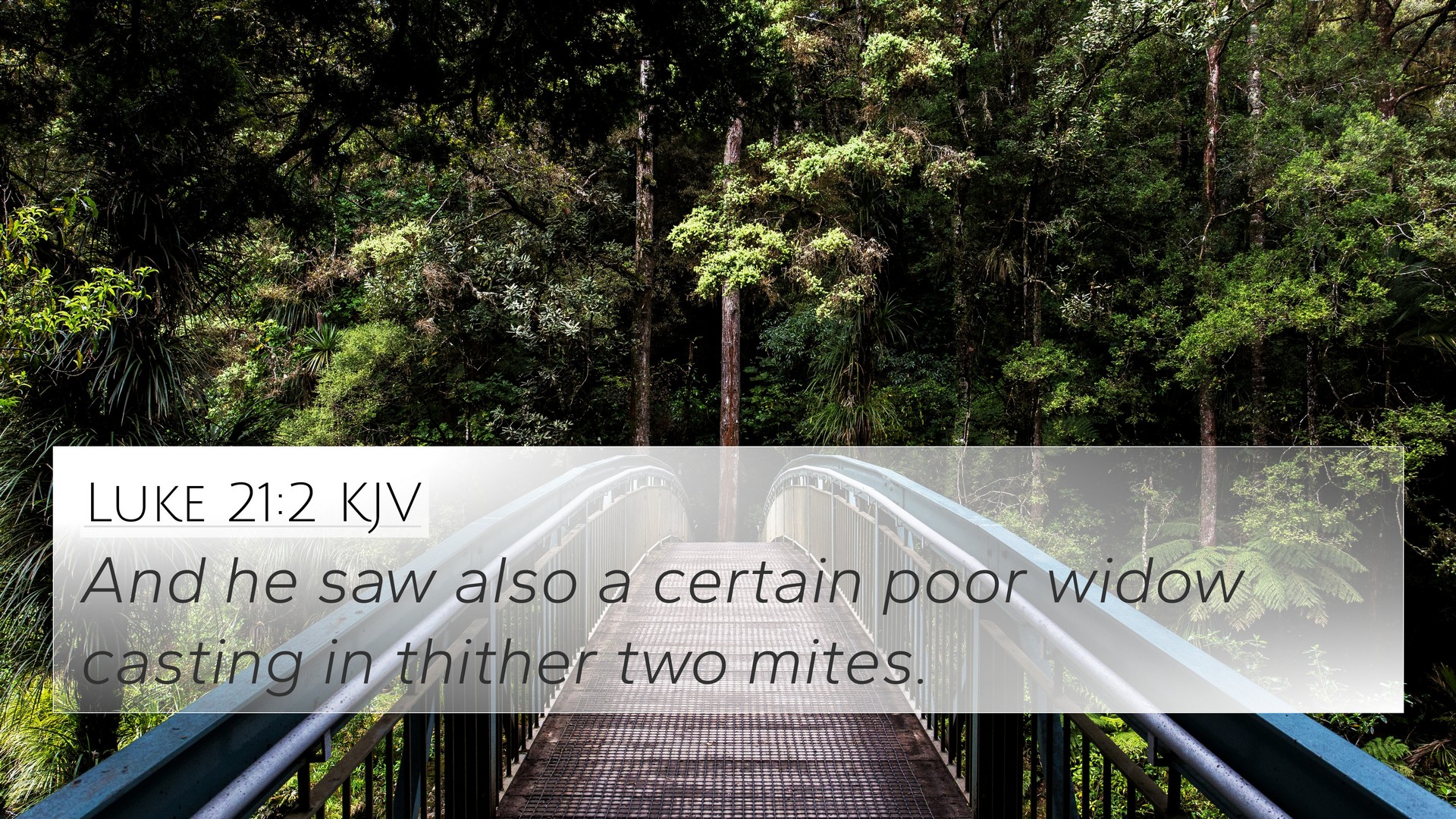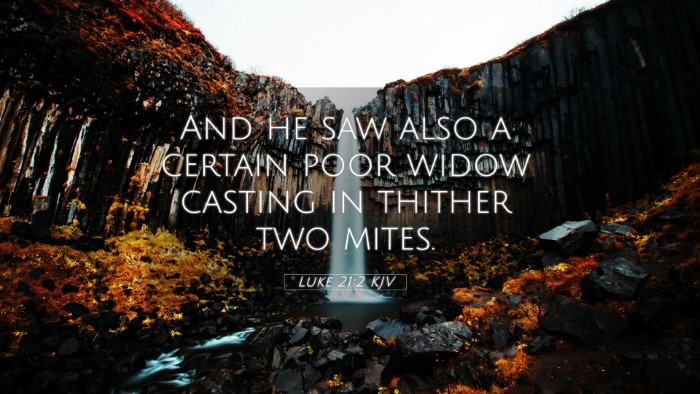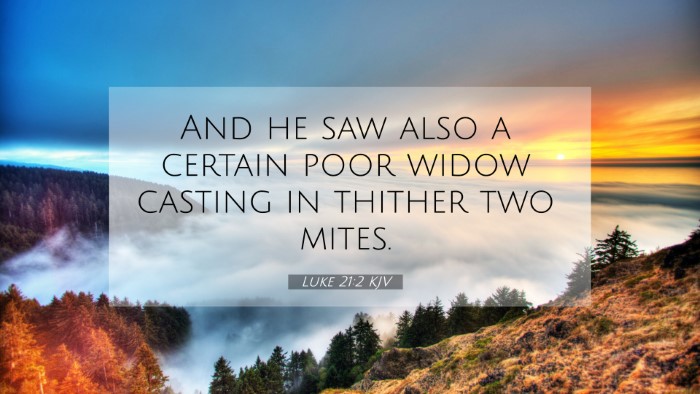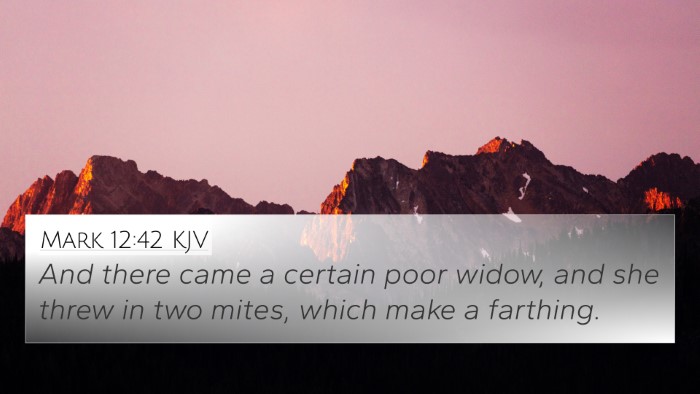Understanding Luke 21:2
In Luke 21:2, we encounter a significant moment where Jesus observes the temple treasury. He notes the rich putting their gifts into the treasury and highlights the contribution of a poor widow, who offered two mites (small coins). This moment is rich with spiritual implications and illustrates key themes in Biblical teachings. Below, we provide a concise analysis of this verse utilizing insights from public domain commentaries to enhance understanding and draw connections across the Scriptures.
Meaning and Insights
Matthew Henry’s Commentary
Matthew Henry emphasizes the contrast between the rich and the widow. He points out that while the rich may have given a substantial amount, their gifts lacked the true spirit of sacrifice. The widow's two mites, although seemingly insignificant in monetary value, represented all that she had. This act illustrates Jesus’ teaching on the importance of the heart's intent over the mere act of giving. Henry insists that God values the quality of our sacrifice rather than the quantity.
Albert Barnes’ Notes
Albert Barnes expands on the context of this verse, noting that Jesus directs His disciples to understand a deeper lesson in giving. The widow’s offering serves as a model of true generosity and faith, as she gave out of her poverty rather than her abundance. Barnes also connects this event to the Biblical principle that God looks upon the heart, suggesting that the widow’s insignificant coins equate to a greater wealth in the spiritual realm, reaffirming the idea that true richness is found in selfless giving.
Adam Clarke’s Commentary
Adam Clarke highlights the temporal nature of the riches displayed by the wealthy donors. He underscores that their contributions, although grand, were fleeting and bore no eternal significance. Clarke brings to light the teaching that worldly wealth has less value than a humble heart committed to God. This verse acts as a reminder that God’s acknowledgment of our gifts is not based on outward appearances but on the weight of our faith and sacrifice.
Key Themes and Cross-References
- Selfless Giving: Luke 21:2 reflects the Biblical principle found in 2 Corinthians 9:7, where Paul highlights the importance of giving cheerfully and willingly.
- God's Perspective on Wealth: This verse connects with James 2:5, which speaks about God choosing the poor and rich in faith. The widow’s offering highlights God’s preference for humble faith.
- Value of Sacrifice: The narrative resonates with Mark 12:41-44, where the same story is recounted, emphasizing the widow’s tremendous faith.
- Heart over Amount: 1 Samuel 16:7 reveals the principle that God looks at the heart rather than outward appearance, paralleling the widow’s genuine offering.
- Riches and Eternity: Matthew 6:19-21 discusses laying up treasures in heaven rather than on earth, mirroring the underlying message of Luke 21:2.
- Faith and Trust in God: The widow’s act ties to Philippians 4:19, where Paul reassures believers of God’s provision when they give wholeheartedly.
- True Wealth: Proverbs 22:9 discusses the blessings of generosity, supporting the theme revealed in the widow's offering that true wealth is generosity in one's means.
- Comparison of Disciples: Reflecting upon Matthew 19:24, where Jesus teaches about the difficulty for the rich to enter the kingdom, emphasizes the stark difference in the widow's attitude in giving.
- Value of Small Acts: Zechariah 4:10 highlights that small beginnings or contributions are valued by God, reinforcing the message of faithfulness in little.
- Serving God with Substance: Mark 10:21 illustrates Jesus’ teaching on the sacrifice that may be required of those who seek to follow Him genuinely, echoing the widow’s total commitment.
The Importance of Cross-Referencing
The insights drawn from Luke 21:2 exemplify the power of cross-referencing Biblical texts. It is essential to understand the connections between Bible verses to grasp the thematic undercurrents that run throughout Scripture. By employing tools for Bible cross-referencing and using a Bible concordance, readers can uncover deeper meanings and apply Scriptural principles relevant to their lives.
How to Utilize Bible Cross-References
To effectively engage in cross-reference Bible study, consider the following methods:
- Use a Bible cross-reference guide to trace thematic links between verses.
- Identify key themes and find verses that support those themes through thorough examination and study.
- Explore narratives in the Gospels and compare teachings to discern consistent messages.
- Engage with historical and cultural context to understand the implications of each verse better.
- Incorporate prayerful meditation on Scripture, allowing the Holy Spirit to reveal connections and deepen understanding.
Conclusion
Luke 21:2 serves as a profound reminder of the nature of true sacrifice in the eyes of God. Through the humble act of the widow, we are called to assess our own giving—both materially and spiritually. The interconnectedness of scriptures surrounding this verse highlights vital theological themes, encouraging us to delve deeper into the Word and discover the fullness of God's teaching through the context of Bible verse connections.



